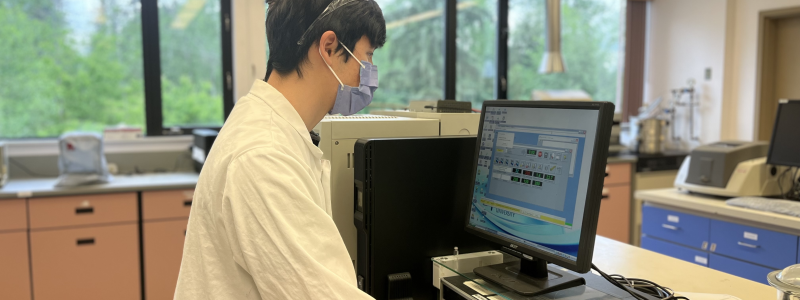Maximillian (Max) Laurence, TWU student and summer researcher, is fascinated by the elementary ingredients of life: chemicals and compounds.
With his passion for scientific inquiry, it seems fitting that when Max first came to TWU his goal was to become a doctor.
Many chemistry courses later, however, Max found himself pondering the idea of a career in chemistry. This fall, he enters his third year of chemistry studies at TWU.
He remarks, “Through what I’ve learned and the many discussions I’ve had with the professors, I’ve become fascinated by chemicals and compounds: they are, after all, the building blocks of everything around us—including us!”
Receiving a federal award to pursue summer research
Max is among the winners of a 2022 NSERC USRA research grant. Provided by the Natural Sciences and Engineering Research Council of Canada, this federally funded award supports students in conducting research for 16 consecutive weeks on a full-time basis.
“Through what I’ve learned and the many discussions I’ve had with the professors, I’ve become fascinated by chemicals and compounds: they are, after all, the building blocks of everything around us—including us!”
Max is pursuing his enthusiasm for the sciences by working on a research project under the supervision of Dr. Miriam Buschhaus.

Investigating functions of plants’ natural covering
The topic of Max and Dr. Buschhaus’ research involves a specific feature of plants that enables their survival: wax.
Wax is one of the many adaptations that allow plants to survive on land. Max explains that a waxy cuticle covers the non-woody surfaces of land plants—think of leaves, petals, and fruits,
“The main function of this cuticle is to prevent plants from drying out,” he continues, “but there are many other secondary functions of the cuticle that scientists are still discovering. These secondary purposes are what we keep in mind as we investigate our two plants.”
“At the moment, we are excited to explore anything we can find out about these plants. After all, no one has looked into these specific features before!”
Examining the Ghost plant and the Sensitive fern
Max and Dr. Buschhaus’ study aims to discover what compounds are present within the cuticular waxes of Monotropa uniflora (Ghost plant) and Onoclea sensibilis (Sensitive fern).
So far, scientists know very little about the waxes of the two plants that Max and Dr. Buschhaus chose for their study. This means that any interesting discoveries made in their research could dovetail into other research projects in the future and spark new areas of inquiry.
“At the moment, we are excited to explore anything we can find out about these plants,” Max enthused. “After all, no one has looked into these specific features before!”

“Each chemical compound has a unique mass fragmentation fingerprint that can identify it. We then take the data produced by the GC/MS and tell the story contained in the plant waxes of these two species.”
Each of the two plants in this study have very interesting distinctives.
Monotropa uniflora, for example, has no chlorophyll.
“Monotropa uniflora gets the nutrients it needs from fungi under the ground,” Max explains, “and these fungi, in turn, parasitize nutrients from surrounding trees.”
He continues, “Photosynthesis is how plants obtain carbon, and since this plant is ‘carbon poor’ (being twice removed from a carbon source), we want to know the impact on the plant’s waxy cuticle and which wax molecules are essential. Wax is a very carbon-intensive molecule, so this plant will use its precious resources only for key compounds.”
As for the Onoclea sensibilis, the researchers selected this plant because the size of its sporophyte and gametophyte stages are sufficiently large to collect wax.
“Plants have a more complex life cycle than we do; they alternate between two ‘generations’—one of them haploid (gametophyte), the other diploid (sporophyte),” Max describes. “We want to see if the waxes of these two stages differ from each other.”
Looking into the stories hidden within chemical compounds
To conduct their study, the researchers will use a Gas Chromatography/Mass spectrometry instrument (GC/MS for short) to identify the plant wax molecules.
GC/MS is a very powerful instrument that many chemists use, Max introduces. He describes how the basic function of this machine is to push compounds into gas phase, separate them based on properties and identify them.
“Each chemical compound has a unique mass fragmentation fingerprint that can identify it,” Max says. “We then take the data produced by the GC/MS and tell the story contained in the plant waxes of these two species.”
A passion for learning and discovery
Max hopes to further his passion for scientific inquiry beyond his time at TWU. When asked about his future aspirations, Max replies, “Whether or not I become a doctor, a chemist (or something in between), one thing is for sure: I want a career where I can explore and try to understand all the many wonders contained within our world!”
About Trinity Western University
Founded in 1962, Trinity Western University is Canada’s premier global Christian liberal arts university. We are dedicated to equipping students to discover meaningful connections between career, life, and the needs of the world. Drawing upon the riches of the Christian tradition, seeking to unite faith and reason through teaching and scholarship, Trinity Western University is a degree-granting research institution offering liberal arts and sciences as well as professional schools in business, nursing, education, human kinetics, graduate studies, and arts, media, and culture. It has four campuses and locations: Langley, Richmond-Lansdowne, Richmond-Minoru, and Ottawa. Learn more at www.twu.ca or follow us on Twitter @TrinityWestern, on Facebook and LinkedIn.
For media inquiries, please contact: media@twu.ca.
The views expressed by students and alumni are their own. They do not necessarily represent the views of Trinity Western University or of any other companies, groups or organizations named.

